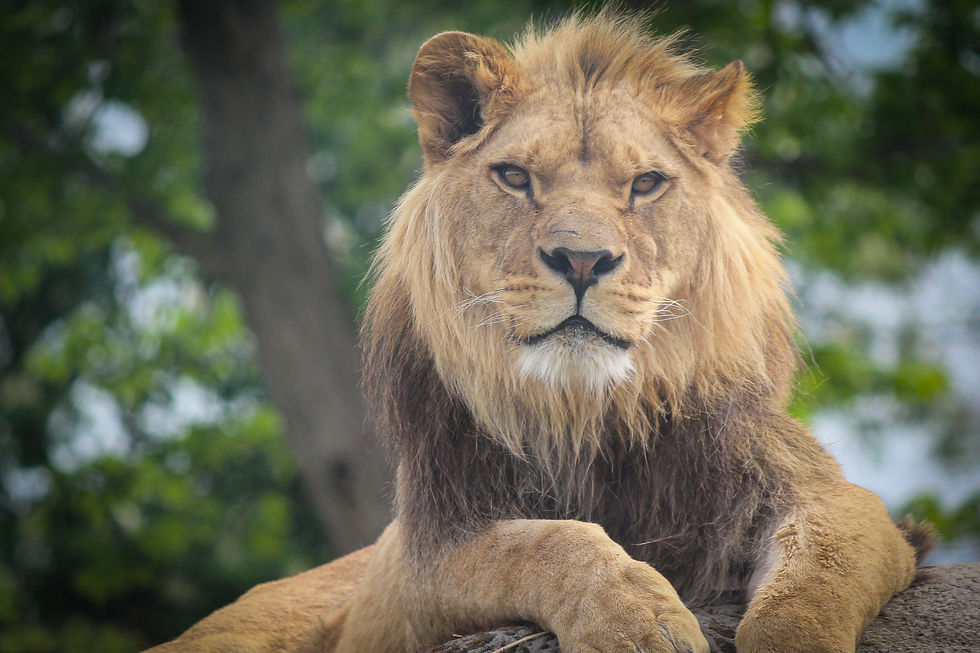Ammit - Eater of the Heavy Heart
- Sylvia Rose

- Nov 30, 2023
- 4 min read
Updated: Mar 25, 2024
The Afterlife of Egypt includes judgment of a life lived. Demonic hybrid Ammit takes her part in the judgment ceremony. She's a triple threat, part lion or leopard, part hippopotamus and part crocodile, merging aspects of the three most dangerous animals in Egypt.
See also:
Ammit is a demon and has no cult of worship. With ceaseless hunger she plays a significant role during the judgment of the Dead. Below, her name in hieroglyphs show two owl figures, as the Owl relates to the Underworld.
When a person dies, the first stop is Duat, the Land of the Dead. Anubis, Underworld God and Guardian of the Scales, holds the hand of the deceased at far left. Here, a representation of the Goddess Ma'at adorns the top of the scales.
See also:
The jackal-headed god Anubis is the dominant underworld figure in c. 2900 BCE. It's also said a cat sits among the judges at the end of a person's life. The divinities weigh the heart of the deceased against a feather of Maat, Goddess of Truth.
The dead person is also given 42 incantations and 42 prayers to recite. Numbers may vary. Thoth, the ibis-headed god of wisdom, magic, medicine, the moon, hieroglyphs and judgment, records the results of the weighing.
See also:
The feather of Ma'at symbolizes balance and truthfulness. The heart or Ib represents the soul of the deceased. The Ib is the key to judgment and the journey to Aaru, paradise of the Egyptians.
The anatomical heart is the haty. The Ib refers to the heart as a metaphysical entity which embodies thought, intelligence, memory, wisdom, bravery, sadness and love. Ib carries a divine flame or light.
See also:
If the heart weighs less than the feather, the deceased is considered pure. The dead person can then undertake the long and perilous journey to Aaru, the Paradise of the Egyptians.
The deceased must get through up to 25 doors, each guarded by a demon, god/dess or ferocious creature. When the deceased finally reaches Aaru, it's a place of peace and abundance, islands of reeds and fertile lands, where souls live in happiness for eternity.
See also:
If the heart weighs more than the feather, it fails the test. Ammit, true to her name Eater of the Heavy Heart, gobbles it up. Soulless, the dead person must remain in the Land of the Dead, regretting for eternity the sins not regretted in life.
These rituals are noted in the Egyptian Book of the Dead. The grave goods of rulers and officials often include copies of the Book of the Dead, so the person is prepared for life beyond the grave.
See also:
During the Middle Kingdom (2000–1700 BC) Osiris begins to replace Anubis as Lord of the Underworld. In the Roman era, beginning c. 30 BC, tomb paintings depict Anubis holding the hand of deceased persons to guide them to Osiris.
Not every culture includes judgment of the Dead. In Mesopotamia for instance one is confirmed to be dead by the Underworld Goddess Ereshkigal, and noted by her scribe. Then, it's up to friends and descendants to supply libations and comforts for the dead.
See also:
Like Egypt with its rich burial sites, Mesopotamia also develops entire cities or necropolises, usually located near a source of water and in the west, the direction of the setting sun. There the dead can live in peace, visited by dutiful descendants.
In ancient Egypt, demons have supernatural powers and hierarchal positions. Ranked below the Gods, they have no place of worship. They're elements of chaos and epitomize evil. Still, they have their uses.
See also:
Ammit is a guardian demon. This type of demon remains true to a certain place, such as the Land of the Dead, Duat. Demons are often hybrids of humans and other animals, shown in grave pictures so the deceased would know them.
Guardian demons appear as a hybrid of animals meant to be feared, incorporating the ferocious traits of the beasts. They were thus easily differentiated from deities associated with humanity.
See also:











